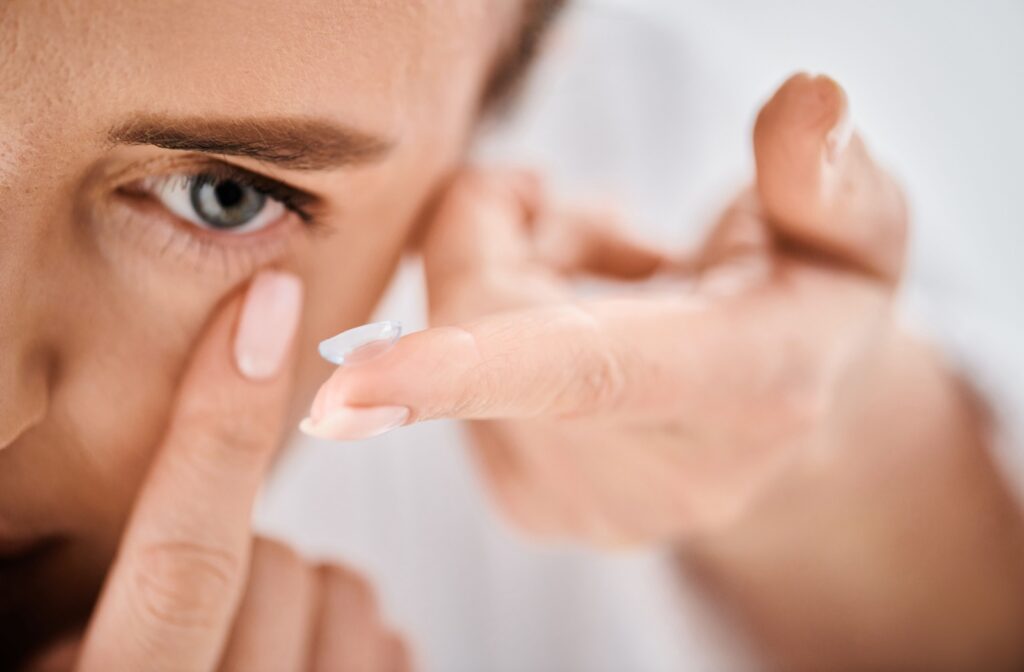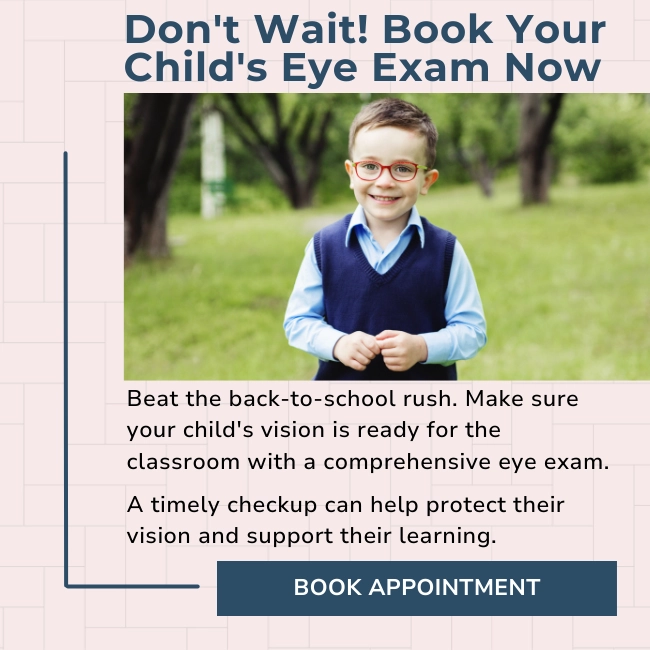Contact lenses are a convenient and helpful eyewear solution for many people, but they can also be a source for discomfort. People who wear contact lenses may experience symptoms of dry eye syndrome such as stinging, burning, a grittiness, or even excess watery tears.
Dry eyes can significantly impact your quality of life, affecting productivity and getting in the way of everyday tasks. Fortunately, there are ways to manage dry eyes if you wear contact lenses, from changing the type of contact lens you wear to altering your environment. Some clinics, including Trail Vision Care Clinic, also offer treatments like Intense Pulsed Light (IPL) therapy and radiofrequency (RF) therapy.
Dry Eyes & Contact Lenses: The Link
To understand the relationship between contact lenses and dry eyes, it’s helpful to review how contact lenses work. A contact lens is a small, clear disc placed directly on the tear film on top of the cornea. Contact lenses work like glasses, correcting refractive errors like myopia (nearsightedness), hyperopia (farsightedness), and astigmatism.
People who wear contact lenses may be especially susceptible to dry eye. For example, some research suggests that contact lenses interfere with the lipid (fatty) and aqueous (water) layers of the tear film. Contact lenses may also affect the proteins in your eyes that are partly responsible for lubrication.
Contact Lens Types
The type of contact lens you choose can also help or hinder dry eye symptoms. There are two main categories of contact lens: soft and hard. Soft contact lenses can be more comfortable for many people, but they are also prone to drying out. It’s also easier for protein and lipid deposits to gather on soft lenses, which can add to discomfort. Hard contacts may be prescribed for those with dry eye disease, but they typically require more time to adapt to.
It’s important to understand how to clean your contact lenses and to be consistent in their care. If your contact lenses cause you discomfort, make an appointment with your optometrist. You have options!
Other Reasons for Dry Eyes
There may be other things to blame for your dry eye symptoms. These include:
- Environmental factors like dry air, wind, pollution, and UV radiation
- Biological factors like age, hormonal changes, and genetics
- Underlying health conditions including thyroid disease, rheumatoid arthritis, and Parkinson’s disease
- Medications such as contraceptives, antihistamines, and antidepressants
Dry Eye Management
Thankfully, there are things you can do to increase your comfort as a contact lens wearer. Ask your optometrist about approved eye drops, lifestyle changes, and other potential treatments.
Hydration
Our bodies are made up of mostly water, and our eyes are no exception. By simply staying hydrated, you may be able to manage symptoms of dry eye. Adequate water intake can help keep your eyes lubricated.
Approved Eye Drops
While eye drops can be a quick and convenient treatment for dry eyes, not all of them are safe to use with contact lenses. Make sure you ask your optometrist for products approved for use with contact lenses.
20-20-20 Rule
Do you spend a lot of time in front of screens? Overusing our eyes this way can cause digital eye strain. A simple habit you can adapt is the 20-20-20 rule: every 20 minutes, look at something 20 feet away for 20 seconds. This gives your eyes a much-needed break and may even alleviate some dry eye symptoms.
Environment
There may be things in the environment that contribute to dry eyes. Wind, dry air, smoke, and pollution can irritate the eyes, so avoid places with these elements if you can. If you spend most of your time inside, consider adding a humidifier to your room.
Other Dry Eye Treatments
If your dry eye symptoms are persistent and first-line treatments aren’t working, ask your optometrist what other treatments are available. The right treatment will depend on the underlying cause of your dry eyes.
Punctal Plugs
These are small devices that can be inserted into the openings where tears drain from the eye. Punctal plugs can keep tears from draining or draining too fast, thus increasing lubrication of the eye. Punctal plugs can be temporary, semi-permanent, or permanent.
Intense Pulsed Light (IPL) Therapy
IPL therapy uses flashes of light to manage dry eye caused by meibomian gland dysfunction (the meibomian glands are responsible for making the oils in your tear film). It’s thought to manage inflammatory mediators and bacterial growth. IPL is also a treatment for skin conditions like acne and rosacea.
Radiofrequency (RF) Therapy
Radiofrequency therapy uses high-frequency electrical currents to heat the skin and stimulate collagen production. Often used in cosmetic treatments, RF can treat dry eye by melting oils that have blocked the meibomian glands.
INMODE Lumecca Intense Pulse Light and INMODE Forma-I radiofrequency treatment are both available at Trail Vision Care Clinic. Contact us to learn more about how they work.
Visit an Optometrist in Trail, BC
Whether it’s the wrong type of contact lens or a dysfunction of the meibomian glands, it’s important to get to the root cause of dry eyes. If you experience symptoms, visit us for an exam. Not sure if you have dry eye? Try our quiz.
Our clinic uses technologies like the OCCULUS Keratograph® 5M to make detailed and full-colour digital images of your eye. We can then investigate the cause of your dry eye and help you find a treatment plan that addresses your personal needs.
We use our eyes every day for work, play, and everything in between. The Canadian Association of Optometrists recommends that most adults ages 20 to 64 get their eyes checked every two years, with some people requiring more frequent appointments based on age and health history. To get a check-up on your eye health in Trail, BC, book an appointment with us at Trail Vision Care Clinic.




